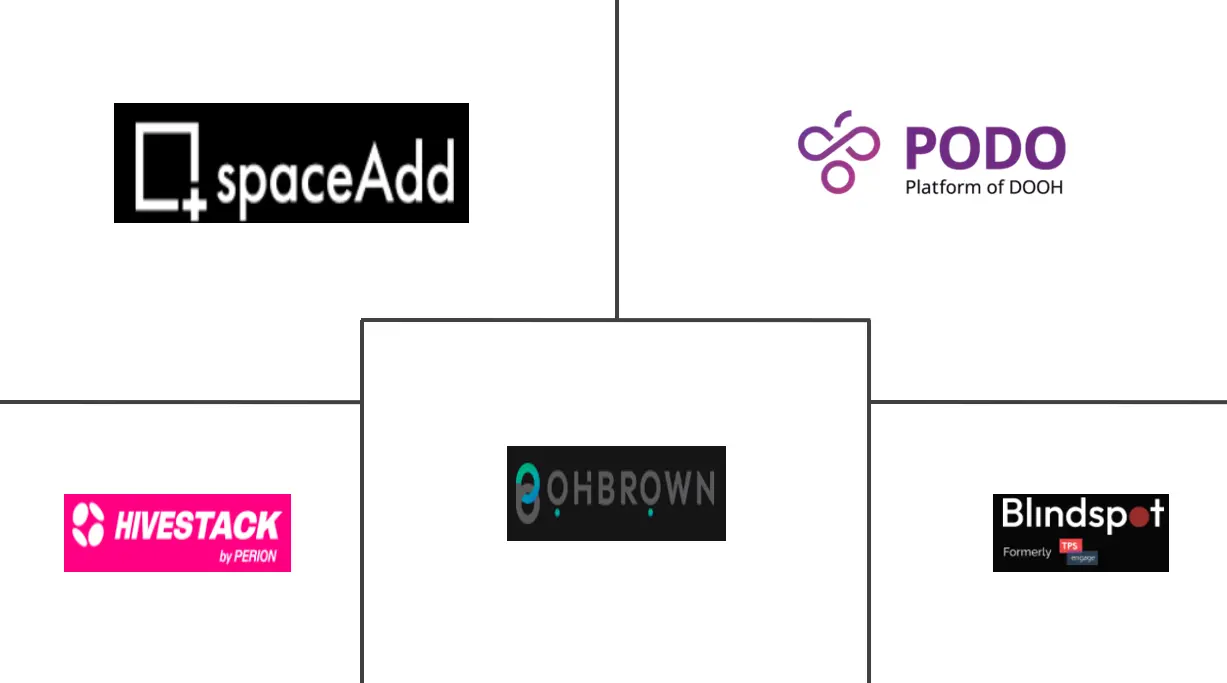South Korea OOH And DOOH Market Size and Share
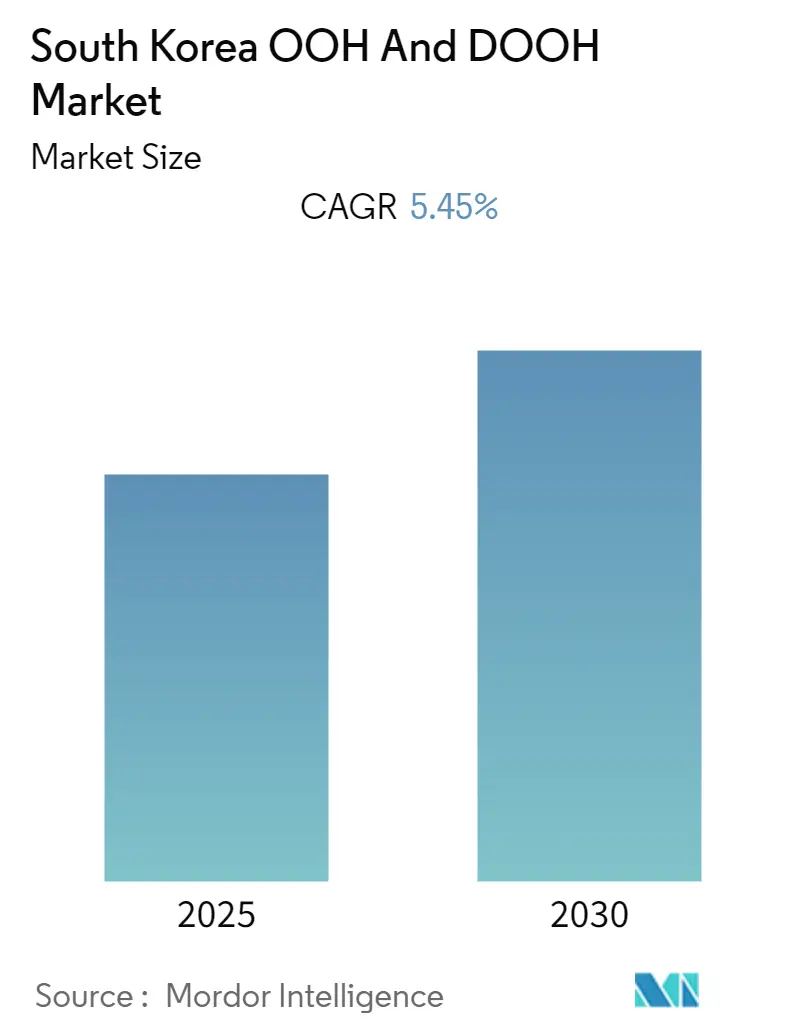
South Korea OOH And DOOH Market Analysis by Mordor Intelligence
The South Korea OOH And DOOH Market is expected to register a CAGR of 5.45% during the forecast period.
- The South Korean OOH and DOOH market has grown significantly over the past few years. Market vendors are integrating digital technologies with traditional advertisement displays in indoor and outdoor public spaces. The offline advertising business in the country is gradually adopting technological innovation, thus positively indicating the market's growth.
- Moreover, due to the rapid advancement of technology over the years, digital out-of-home advertising has gained significant popularity among marketers and advertisers in South Korea due to its ability to reach a large and diverse audience. Compared to traditional out-of-home advertising, digital out-of-home screens can provide a more focused advertising platform. DOOH helps advertisers create impactful, entertaining, and dynamic advertisements that are targeted to specific audiences based on data such as location, weather, time, and demographics.
- Thus, the growth of DOOH signage, coupled with the development of smart cities, has allowed advertisers to take advantage of and reap its benefits, which is expected to drive the market's growth during the forecast period. Smart city projects use various digital displays to ensure the smooth functioning of the city, and every digital screen is a potential source of advertising money. Such developments create significant scope for expansion of the South Korean OOH and DOOH market during the forecast period.
- Further, the South Korean government's active role in offering free advertising zones in the country is further propelling the market's growth and creating significant growth opportunities for market vendors. For instance, in December 2023, the Ministry of the Interior and Safety announced that Myeongdong and Gwanghwamun Square in Seoul have been designated as ‘outdoor advertising free display zones.’ These areas will be transformed into advertising and media hotspots like Times Square in Manhattan, New York.
- In the coming years, technological advancements and growth in business expansion create opportunities for market vendors to help brands reach their target customers. The technological innovations in outdoor media with digital capabilities enable businesses to create an impact while also understanding the impact of the campaigns across the full marketing funnel, which is driving the demand for the market across businesses from various sectors across South Korea.
South Korea OOH And DOOH Market Trends and Insights
The Transportation Segment is Expected to Hold a Major Share in the Market
- The transportation segment, notably airports, is analyzed to hold a significant market share in the South Korean OOH and DOOH market during the forecast period. The growing prominence of airport advertising is gaining significant traction in the country, with many major market vendors, such as Sovereign Comm Inc., offering OOH and DOOH advertising on airports.
- For instance, Sovereign Comm Inc. covers all South Korean airports, including Daegu (TAE), Seoul Gimpo (GMP), Jeju (CJU), Incheon (ICN), Busan (PUS), and Cheongju (CJJ). The company offers static and digital formats covering all areas, including boards near the airport.
- Transit displays are primarily installed in public vehicles and transit stations, providing advertisers with a captive audience during commutes. Transit DOOH and OOH are some of the emerging advertising methods for connecting with commuters. The increasing number of public transportation facilities across South Korea is expected to enhance the applications of transit displays.
- Further, the expanding transportation sector, characterized by the growing contribution to the total GDP, is analyzed to strengthen the application of OOH and DOOH in the transportation sector in the country. It is expected to create significant growth opportunities for market vendors to expand transit advertising. For instance, according to the data from KOSIS KOrean Statistical Information Service and Bank of Korea, in 2023, approximately USD 54.40 billion was generated as real GDP by the transportation sector in South Korea.
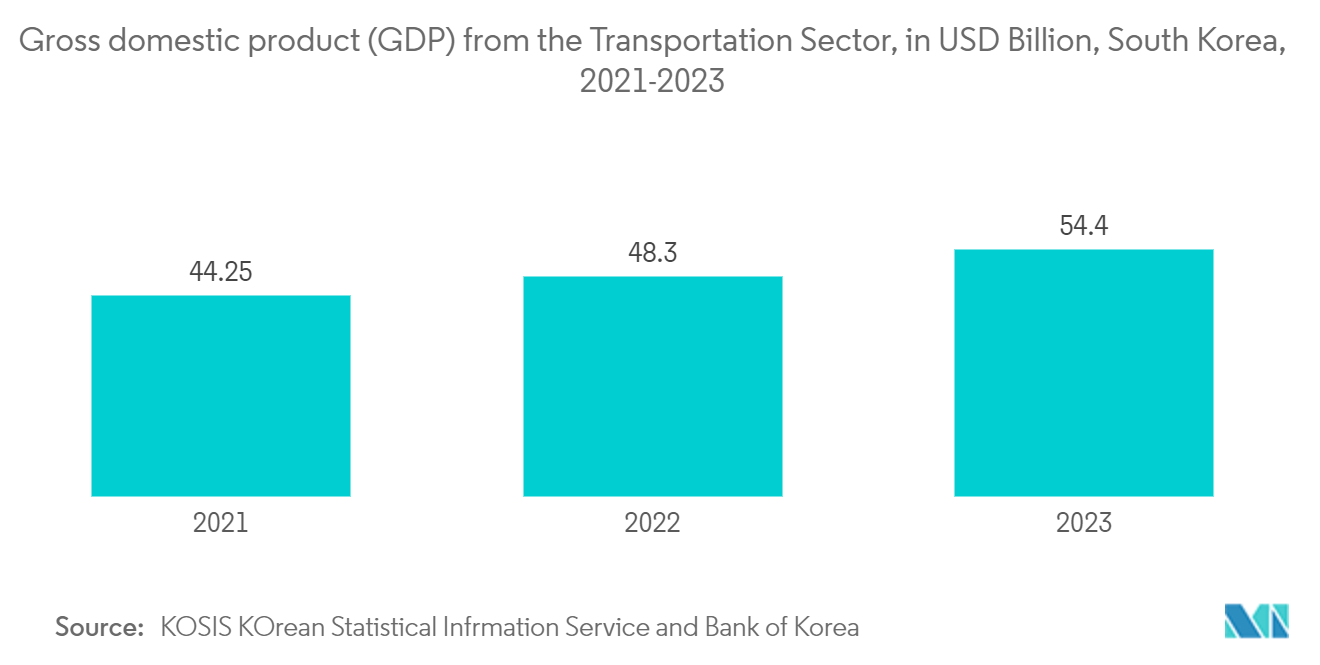
The Retail and Consumer Goods Segment is Expected to Hold a Significant Share in the Market
- The retail and consumer goods segment is analyzed to drive the growth of the South Korean OOH and DOOH market during the forecast period. E-commerce, growing consumer spending, online shopping, and changing consumer behavior are expected to be significant factors driving the growth of South Korea's retail and consumer goods industry. As the industry grows and rapidly evolves, retailers in the country are constantly investing in digital out-of-home advertising to attract customers and increase their market sales.
- Further, the country's retail sector has grown significantly over the past few years. This significant growth in revenue creates significant scope for retail advertising, thus driving the market's growth. For instance, according to the data from MOTIE (South Korea), in 2023, retail sales in South Korea grew by 6.3% compared to the previous year.
- Furthermore, in May 2024, the Ministry of Trade, Industry, and Energy announced that Korea’s retail industry grew by 10.8% YoY in April 2024. The ministry's data also showed that offline sales dipped by 0.2% while online sales surged by 22.2%. With this growth in the retail sector, DOOH advertising is emerging as a powerful tool in the country's retail and consumer goods sector to enable brands to reach their target audience effectively and in a budget-friendly manner.
- The retail industry is projected to hold a substantial portion of South Korean digital out-of-home and out-of-home spending during the forecast period. This trend is fueled by a rising inclination among retailers to integrate out-of-home media into their advertising strategies to increase sales and boost customer acquisition.
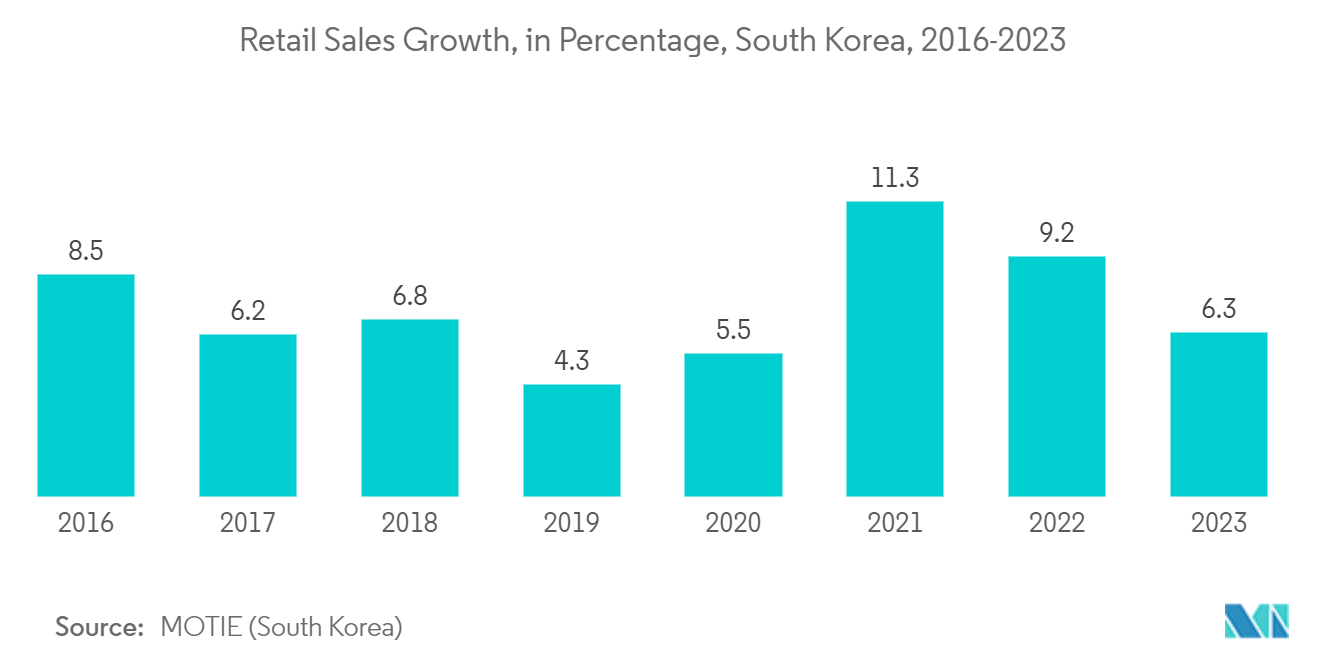
Competitive Landscape
The South Korean OOH and DOOH market is fragmented, with a significant number of players. A combination of accelerating growth in end-user advertising spending and continuous technological advancements resulted in a strong rivalry in the market. Further, the partnership, acquisition, and merger activities in the market are further analyzed to intensify the competitive rivalry in the market.
- February 2024: The South Korean OOH advertising sector announced the ‘OOH Advertising Effectiveness Metrics Standardization Alliance.' This collaborative effort, which includes advertising agencies, media firms, AI solution providers, and relevant government bodies, is dedicated to setting a standard for scientifically measuring OOH advertising effectiveness. Comprising 30 OOH companies, the Alliance's primary goal is to develop crucial metrics like foot traffic and viewership (attention rates). Additionally, it aims to chart mid-to-long-term strategies for a data platform that caters to a broad spectrum of users, from advertising agencies to media companies.
- January 2024: The South Korean government approved the establishment of iconic DOOH zones in three places in Seoul and Busan. Owing to significant regulatory relaxations, these new DOOH-free zones are poised to draw global attention, potentially rivaling the fame of iconic spots like Times Square or Piccadilly Circus. Notably, these zones allow for the installation of approximately 20 LED boards, all at no cost.
South Korea OOH And DOOH Industry Leaders
-
OHBROWN
-
spaceAdd
-
Blindspot
-
PODOOH MEDIA NETWORK
-
Hivestack
- *Disclaimer: Major Players sorted in no particular order
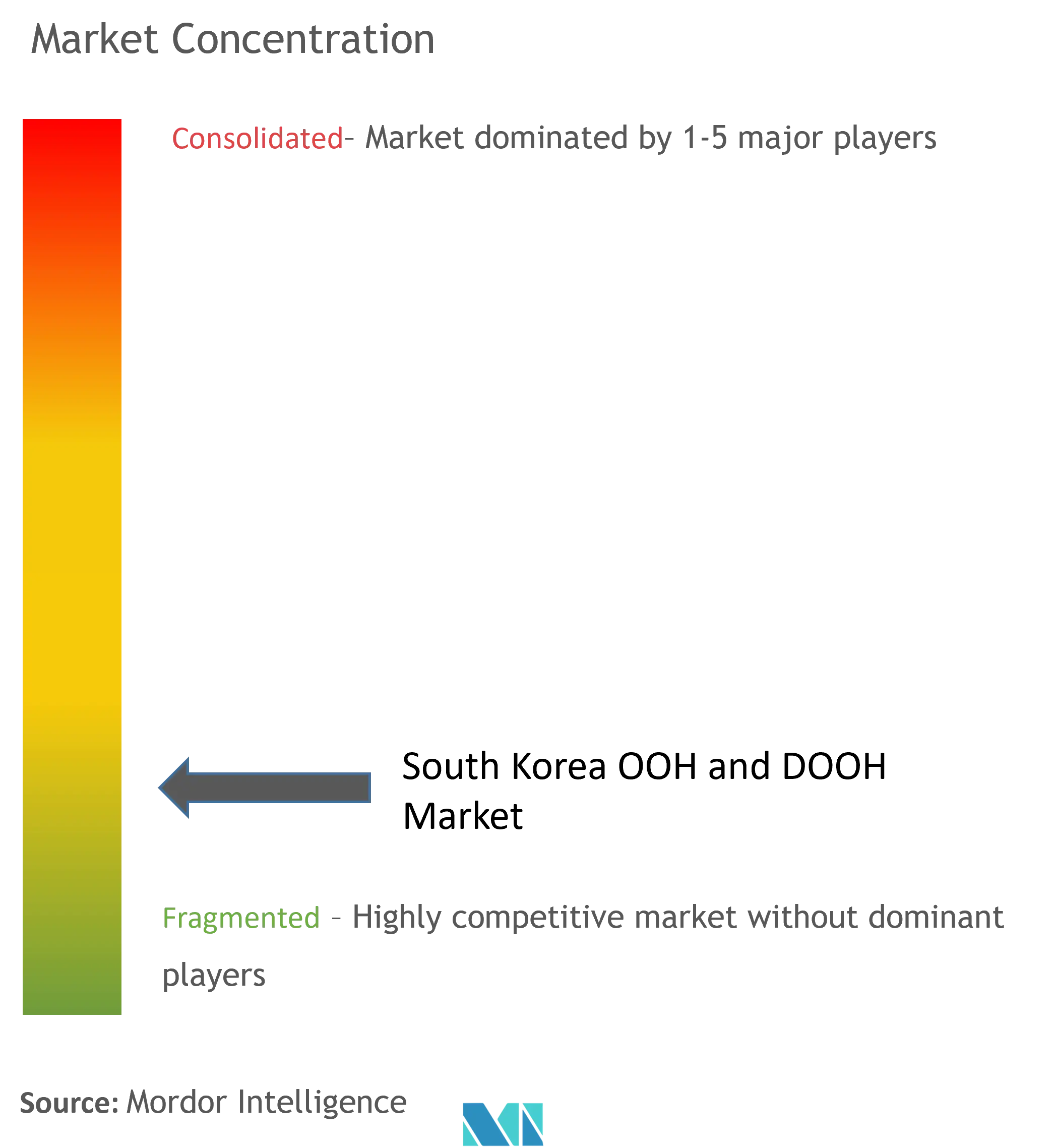
Recent Industry Developments
- June 2024: Tizen unveiled its plans for extensive offline advertising in Seoul, slated to run for about a month, wrapping buses in prominent zones like Gangnam and Gangbuk. Additionally, the campaign features on media platforms within iconic structures in pivotal office hubs, including Gwanghwamun, Gangnam, Yeouido, and Pangyo.
- February 2024: Korea Economic Daily (KED) secured a significant seven-year deal aimed at overhauling advertising media at Incheon International Airport, South Korea's primary entry point. As part of the agreement, KED will replace the airport's traditional static advertising lightboxes with cutting-edge LED displays in Terminal 1 and Terminal 2. Concurrently, KED pledges to bolster and broaden Incheon International Airport's existing Digital Out-of-Home (DOOH) offerings.
South Korea OOH And DOOH Market Report Scope
The study tracks the advertising spending on various OOH formats, including billboards (city-light boards), street furniture (city-light posters), transit and transportation (advertising in and on vehicles used for public transportation), and place-based media (media at the point of sale). The scope of the study includes digital and static advertisements placed indoors and outdoors at shopping malls, airports, streets, and transit. The commission and production costs of agencies are excluded from the scope of work.
The South Korean OOH and DOOH market is segmented by type [static (traditional) OOH and digital OOH ( programmatic OOH and others)], application [billboards, transportation (airports and others (buses, etc.), street furniture, and other placed-based media], and end-user industry [automotive, retail and consumer goods, healthcare, BFSI, and other end-user industries]. The market sizes and forecasts are provided in terms of value (USD) for all the above segments.
| Static OOH | |
| Digital OOH | Programmatic OOH |
| Others |
| Billboard | |
| Transportation | Airports |
| Others | |
| Street Furniture | |
| Other Place-based Media |
| Automotive |
| Retail and Consumer Goods |
| Healthcare |
| BFSI |
| Other End-user Industries |
| By Type | Static OOH | |
| Digital OOH | Programmatic OOH | |
| Others | ||
| By Application | Billboard | |
| Transportation | Airports | |
| Others | ||
| Street Furniture | ||
| Other Place-based Media | ||
| By End-user Industry | Automotive | |
| Retail and Consumer Goods | ||
| Healthcare | ||
| BFSI | ||
| Other End-user Industries | ||
Key Questions Answered in the Report
What is the current South Korea OOH And DOOH Market size?
The South Korea OOH And DOOH Market is projected to register a CAGR of 5.45% during the forecast period (2025-2030)
Who are the key players in South Korea OOH And DOOH Market?
OHBROWN, spaceAdd, Blindspot, PODOOH MEDIA NETWORK and Hivestack are the major companies operating in the South Korea OOH And DOOH Market.
What years does this South Korea OOH And DOOH Market cover?
The report covers the South Korea OOH And DOOH Market historical market size for years: 2019, 2020, 2021, 2022, 2023 and 2024. The report also forecasts the South Korea OOH And DOOH Market size for years: 2025, 2026, 2027, 2028, 2029 and 2030.
Page last updated on:
South Korea OOH And DOOH Market Report
Statistics for the 2025 South Korea OOH And DOOH market share, size and revenue growth rate, created by Mordor Intelligence™ Industry Reports. South Korea OOH And DOOH analysis includes a market forecast outlook for 2025 to 2030 and historical overview. Get a sample of this industry analysis as a free report PDF download.
